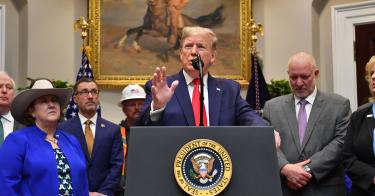Some two dozen state attorneys general are suing the Trump administration to block reforms of a 50-year-old regulation that would otherwise speed the nation’s economic recovery from COVID-19 and expedite construction of safer bridges and highways. How 2020!
The reforms involve the National Environmental Policy Act (NEPA), a statute crafted in 1969 to inject environmental stewardship into federal agency actions. The act requires every executive branch department to assess the environmental effects of “major” public works projects and other budgetary and regulatory actions with potentially “significant” effects.
Once the vanguard of environmental law, the NEPA now embodies arbitrary standards, politicized enforcement, and protracted litigation. Its expansive reach presents endless opportunities for bureaucratic wrangling, and green activists exploit judicial review of NEPA procedures to delay or prevent highway, pipeline, electricity transmission, water resource, broadband-upgrade and other projects.
Between 2013 and 2017, for example, the average environmental impact statement required for permitting ran 669 pages and took 4.5 years to complete.
The revised rules streamline the process without sacrificing environmental protection. There are dozens, if not hundreds of other federal and state regulations that protect water and air quality, wetlands, and endangered species, and that control runoff, hazardous waste, construction debris, demolition dust and every other potential byproduct of infrastructure improvements.
There has not been any comprehensive reform of the NEPA regulations since 1978, and the process reflects many of the vexing problems associated with the administrative state. The statute’s broad aspirational language effectively delegates lawmaking authority to agencies while courts, in turn, have granted deference to agencies’ myriad statutory interpretations.
What really vexes the AGs (and the green lobby) is the Trump administration’s attempt to rein in the politicization of the permitting process. Two of the most important reforms bear directly on whether and/or how carbon dioxide, methane, and emissions of other purported greenhouse gases should be incorporated into environmental impact analyses—perhaps the most contrived means of controlling permitting decisions.
The reforms effectively eliminate the consideration of “cumulative effects” of agencies’ actions, which are, by their nature, highly speculative and many of which, such as potential climate change, are well beyond the control of either agencies or permit applicants. Indeed, determining the geographic and temporal scope of such effects has proven to be, in many cases, more political science than sound science.
The original rules also directed agencies to “rigorously explore and objectively evaluate all reasonable alternatives” to agency action. The new rules were written without the “all”—a sensible check on unnecessarily costly and time-consuming assessments. “Reasonable alternatives” is now defined as “alternatives that are technically and economically feasible, meet the purpose and need for the proposed action, and, where applicable, meet the goals of the applicant.” To consider infeasible alternatives would waste the resources of both agencies and applicants while delaying public health and safety benefits that accrue from infrastructure improvements.
These and other reforms should end the unwarranted consideration in the NEPA process of so-called greenhouse gas emissions. Indeed, no single federal action undergoing a NEPA review could possibly alter the climate, so there is no rational basis for incorporating a climate change assessment.
Moreover, the potential effects of so-called greenhouse gas emissions are inherently speculative; the science is far from settled about what volume—if any—of carbon-dioxide (and other) emissions would provoke changes in climate. If such a causal relationship were to exist, the volume of emissions necessary to provoke it would be global in scale and not attributable to any single agency action—under any circumstance.
Since its enactment in 1970, the NEPA has persisted despite dramatic changes in America’s economic and environmental landscapes—and despite enactment of countless other federal and state regulations. The act is redundant and should be repealed. Absent congressional leadership to do so, the Trump administration’s reforms address several of the most problematic elements of the NEPA process and should be upheld.
This piece originally appeared in The Washington Times



